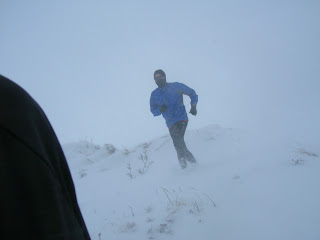First off, I need to clarify that I enjoy backcountry cooking. Many people recommend just carrying prepackaged food and energy bars. However, I consider cooking up a good meal at the end of a long day one of the joys of backpacking. I am not willing to give that up.
Also, I have some unique dietary preferences (I have been
Primal for over two years) that make finding adequate prepackaged food difficult. I will talk about food selection in a later post.
Anyway, I will be cooking my morning and evening meals, and therefore must have some sort of cooking gear.
For now lets start by taking a look at my current backpacking cooking system. Like most backpackers, I already have a fairly light weight cooking set up. It was built more for versatility and dependability than being truly ultralight. In fact that is true of almost all of my gear (not to mention that most of it is for winter camping.)

Here is the MSR
Whisperlite International (an old model), and Snow Peak
Trek 900 Titanium Cook Set combination I have used for a number of years.
It packs down fairly small, and the stove fits nicely inside the pot. However the stove weighs quite a bit (and that is without a fuel bottle.) It was designed to be a sturdy, reliable multi-fuel stove, not ultralight.


The other problem with this system is that the two were designed with different uses in mind. The pot was designed for use with a butane canister stove. It is a very nice pot (I really like Snow Peak), but the tall narrow design, while a perfect fit for butane canisters, is naturally unstable.

Basically the stove is designed to handle much larger pots (yeah, the wind screen is way to big too,) and is far to heavy for fastpacking.
Several lighter solutions are available to the prospective ounce counter (the lightest solution would be to just build a fire, but I don't expect to have the energy for that).
Butane stoves: These stoves can be very light weight, but the canisters are fairly heavy (and impossible to find around here.) I had one years ago (when I first started backpacking), that broke the first time I tried to cook (it was a cheap off-brand model, but was very proud of it when I got it.)
Fuel tabs: An even lighter solution is solid fuel tablets such as those made by
Esbit. Fuel tabs are interesting, but they don't seem to offer much versatility as far as cooking goes. They are ideal for someone who just wants to boil water.
Alcohol stoves: Another solution, favored by many ultralight enthusiasts, is the alcohol stove. These come in countless variations from homemade to expensive titanium models. Basically, you pour alcohol in the burner and light it on fire. That is pretty much it, no mechanical parts to break. There are far to many models and variations to compare benefits and drawbacks of them all. Instead I will give you a brief overview of the main contruction types: homemade aluminum, titanium and brass.
Obviously homemade is the cheapest, but these "soda-can stoves" can be very effective if
properly constructed, and extremely light weight. However, aluminum can also be crushed pretty easily if you are careless.
Titanium is also very light, but extremely durable. The only downside is they are expensive.
Brass is much heavier (though still pretty darn light,) but does have a couple advantages. The stoves made by Tiangia and Esbit come with a lid (so that the fuel may be stored inside the stove,) and a simmer ring (to allow much better control.)
Personally, I require something reliable and reasonably durable (I have a thing about being prepared). Also, It needs to allow me to actually cook, but still keep weight to a minimum.
I chose the brass Esbit
alcohol burner, along with a titanium
Clikstand pot support and windscreen. I also picked up a new Evernew
900ml Ti DX2 Non-Stick Pot Set to match the set.

The combination is considerably lighter than my old one.

It also works together very well (the Snow Peak pot was to small for easy use with the stand.)


It also packs down quite well.

The pots are both 900ml, but the frying pan is much larger on the Evernew model. The only down side is the design of the handle on the Evernew frying pan. It does not work as easily with the wind screen as the Snow Peak design.
Did I make a good choice? Did you have better recommendations? Let me know what you think.
Next time, I will be doing some initial testing of the setup.









